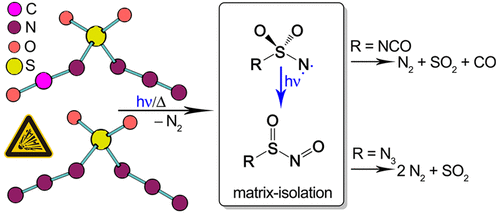当前位置:
X-MOL 学术
›
J. Phys. Chem. A
›
论文详情
Our official English website, www.x-mol.net, welcomes your
feedback! (Note: you will need to create a separate account there.)
Decomposition of Sulfonyl Azide Isocyanate and Sulfonyl Diazide: The Oxygen-Shifted Curtius Rearrangement via Sulfonyl Nitrenes
The Journal of Physical Chemistry A ( IF 2.7 ) Pub Date : 2018-10-15 00:00:00 , DOI: 10.1021/acs.jpca.8b06655 Xuelin Dong 1 , Guohai Deng 1 , Jian Xu 1 , Hongmin Li 1 , Xiaoqing Zeng 1
The Journal of Physical Chemistry A ( IF 2.7 ) Pub Date : 2018-10-15 00:00:00 , DOI: 10.1021/acs.jpca.8b06655 Xuelin Dong 1 , Guohai Deng 1 , Jian Xu 1 , Hongmin Li 1 , Xiaoqing Zeng 1
Affiliation

|
Sulfonyl azide isocyanate, (OCN)S(O)2N3, was prepared and characterized by IR (gas, matrix-isolation), Raman (liquid), and UV–vis spectroscopy. Upon flash vacuum pyrolysis (FVP) at ca. 1000 K, gaseous (OCN)S(O)2N3 decomposes completely and yields fragments N2, SO2, SO3, NCN, N3, NCO, CO, CN, and NO. In contrast, the azide splits off N2 and furnishes a transient triplet sulfonyl nitrene intermediate (OCN)S(O)2N upon a 266 nm laser irradiation in solid Ne-matrix at 2.8 K. Subsequent photolysis of the nitrene with visible light (λ = 380–450 nm) results in oxygen-shifted Curtius rearrangement to a novel nitroso sulfoxide (OCN)S(O)NO. For comparison, the photodecomposition of the closely related sulfonyl diazide O2S(N3)2 in a solid Ar matrix was also studied. Upon an ArF excimer laser (193 nm) photolysis, O2S(N3)2 decomposes and yields N2, SO2, and OSNNO via the intermediacy of an elusive sufonyl nitrene N3S(O)2N. Further visible light irradiation (λ > 395 nm) leads to depletion of N3S(O)2N and OSNNO and concomitant formation of SO2 and N2. The identification of the intermediates in cryogenic matrixes by IR spectroscopy was supported by 15N-labeling experiments and quantum chemical calculations. The mechanism for the decomposition of both sulfonyl azides (OCN)S(O)2N3 and O2S(N3)2 was discussed on the basis of the observed intermediates and the calculated potential energy profiles.
中文翻译:

磺酰基叠氮化物异氰酸酯和磺酰基二叠氮化物的分解:通过磺酰基硝基进行氧位移的库蒂斯重排
制备了叠氮化磺酰异氰酸酯(OCN)S(O)2 N 3,并通过红外光谱(气体,基质分离),拉曼光谱(液体)和紫外可见光谱进行了表征。在快速真空热解(FVP)下于约200℃。气态(OCN)S(O)2 N 3在1000 K下完全分解,生成碎片N 2,SO 2,SO 3,NCN,N 3,NCO,CO,CN和NO。相反,叠氮化物会分离出N 2并提供一个瞬态三重态磺酰亚硝基中间体(OCN)S(O)2N在2.8 K的固体Ne矩阵中以266 nm激光辐照后产生。随后,可见光(λ= 380–450 nm)对腈进行光解,导致氧迁移后的Curtius重排成新的亚硝基亚砜(OCN)S(O )不。为了进行比较,还研究了紧密相关的磺酰二叠氮化物O 2 S(N 3)2在固态Ar基体中的光分解。在ArF准分子激光(193 nm)上光解后,O 2 S(N 3)2分解,并通过难以捉摸的亚磺酰亚砜N 3 S(O)2 N产生N 2,SO 2和OSNNO 。进一步的可见光辐照(λ> 395 nm)导致N的耗尽3 S(O)2 N和OSNNO以及伴随形成的SO 2和N 2。15个N标记实验和量子化学计算为通过红外光谱鉴定低温基质中的中间体提供了支持。基于观察到的中间体和计算出的势能曲线,讨论了磺酰叠氮化物(OCN)S(O)2 N 3和O 2 S(N 3)2的分解机理。
更新日期:2018-10-15
中文翻译:

磺酰基叠氮化物异氰酸酯和磺酰基二叠氮化物的分解:通过磺酰基硝基进行氧位移的库蒂斯重排
制备了叠氮化磺酰异氰酸酯(OCN)S(O)2 N 3,并通过红外光谱(气体,基质分离),拉曼光谱(液体)和紫外可见光谱进行了表征。在快速真空热解(FVP)下于约200℃。气态(OCN)S(O)2 N 3在1000 K下完全分解,生成碎片N 2,SO 2,SO 3,NCN,N 3,NCO,CO,CN和NO。相反,叠氮化物会分离出N 2并提供一个瞬态三重态磺酰亚硝基中间体(OCN)S(O)2N在2.8 K的固体Ne矩阵中以266 nm激光辐照后产生。随后,可见光(λ= 380–450 nm)对腈进行光解,导致氧迁移后的Curtius重排成新的亚硝基亚砜(OCN)S(O )不。为了进行比较,还研究了紧密相关的磺酰二叠氮化物O 2 S(N 3)2在固态Ar基体中的光分解。在ArF准分子激光(193 nm)上光解后,O 2 S(N 3)2分解,并通过难以捉摸的亚磺酰亚砜N 3 S(O)2 N产生N 2,SO 2和OSNNO 。进一步的可见光辐照(λ> 395 nm)导致N的耗尽3 S(O)2 N和OSNNO以及伴随形成的SO 2和N 2。15个N标记实验和量子化学计算为通过红外光谱鉴定低温基质中的中间体提供了支持。基于观察到的中间体和计算出的势能曲线,讨论了磺酰叠氮化物(OCN)S(O)2 N 3和O 2 S(N 3)2的分解机理。






























 京公网安备 11010802027423号
京公网安备 11010802027423号